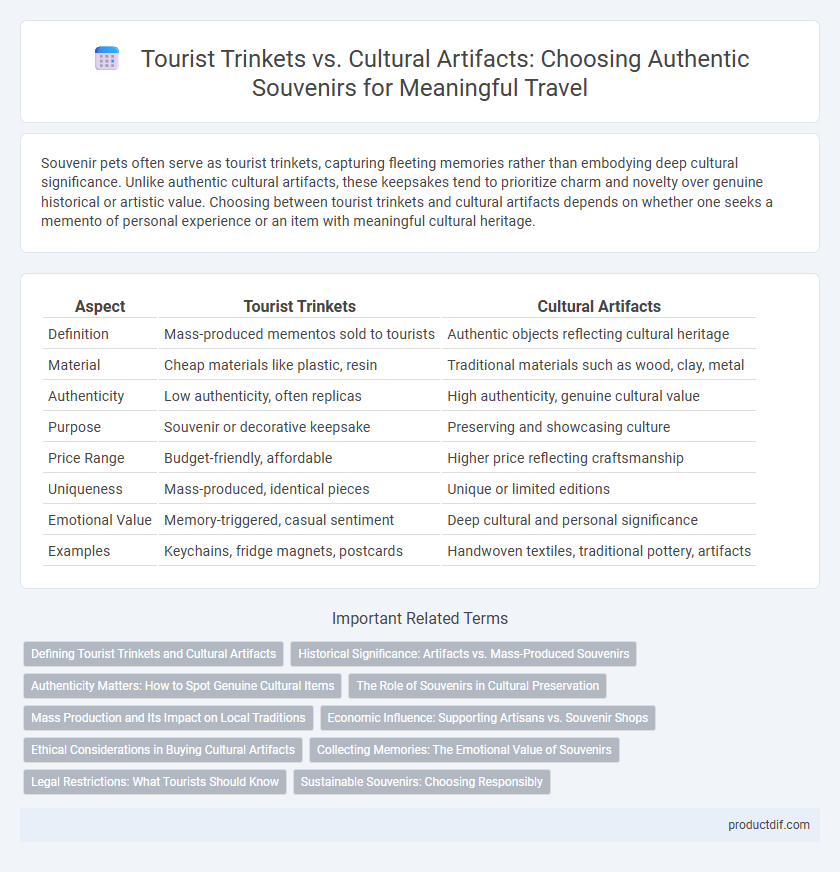Souvenir pets often serve as tourist trinkets, capturing fleeting memories rather than embodying deep cultural significance. Unlike authentic cultural artifacts, these keepsakes tend to prioritize charm and novelty over genuine historical or artistic value. Choosing between tourist trinkets and cultural artifacts depends on whether one seeks a memento of personal experience or an item with meaningful cultural heritage.
Table of Comparison
| Aspect | Tourist Trinkets | Cultural Artifacts |
|---|---|---|
| Definition | Mass-produced mementos sold to tourists | Authentic objects reflecting cultural heritage |
| Material | Cheap materials like plastic, resin | Traditional materials such as wood, clay, metal |
| Authenticity | Low authenticity, often replicas | High authenticity, genuine cultural value |
| Purpose | Souvenir or decorative keepsake | Preserving and showcasing culture |
| Price Range | Budget-friendly, affordable | Higher price reflecting craftsmanship |
| Uniqueness | Mass-produced, identical pieces | Unique or limited editions |
| Emotional Value | Memory-triggered, casual sentiment | Deep cultural and personal significance |
| Examples | Keychains, fridge magnets, postcards | Handwoven textiles, traditional pottery, artifacts |
Defining Tourist Trinkets and Cultural Artifacts
Tourist trinkets are mass-produced items designed primarily for commercial sale to visitors, often lacking authentic cultural significance or traditional craftsmanship. Cultural artifacts, on the other hand, are genuine objects created within a cultural or historical context, embodying the heritage, beliefs, and artistic expressions of a specific community. Understanding this distinction is crucial for appreciating the cultural value and authenticity embedded in artifacts compared to the novelty-driven nature of tourist trinkets.
Historical Significance: Artifacts vs. Mass-Produced Souvenirs
Historical significance distinguishes cultural artifacts from tourist trinkets, as artifacts represent unique, authentic items linked to specific historical events or traditions. Mass-produced souvenirs often lack this depth, serving primarily as commercial keepsakes without intrinsic cultural meaning. Museums and heritage sites prioritize the preservation of artifacts to maintain accurate historical narratives, whereas trinkets cater to broad consumer appeal.
Authenticity Matters: How to Spot Genuine Cultural Items
Tourist trinkets often prioritize mass production and visual appeal, while authentic cultural artifacts embody traditional craftsmanship and historical significance. Genuine items display distinctive materials, intricate details, and provenance that links them to a specific culture or community. Verifying authenticity involves researching origin, consulting experts, and examining seller credibility to ensure meaningful cultural representation.
The Role of Souvenirs in Cultural Preservation
Souvenirs serve as tangible connections between tourists and the cultures they visit, often reflecting local traditions and craftsmanship. While tourist trinkets are mass-produced items with limited cultural significance, authentic cultural artifacts embody the heritage, stories, and artistic practices of a community. The preservation of cultural identity relies on promoting genuine souvenirs that support artisans and maintain the integrity of cultural expressions within the global tourism market.
Mass Production and Its Impact on Local Traditions
Mass production of tourist trinkets often leads to the dilution of local cultural traditions by prioritizing quantity over authenticity, resulting in generic souvenirs lacking genuine cultural significance. In contrast, cultural artifacts hold intrinsic value as they embody traditional craftsmanship and heritage passed down through generations, reflecting the unique identity of a community. The proliferation of mass-produced items threatens the preservation of these authentic cultural expressions by overshadowing handmade, meaningful artifacts.
Economic Influence: Supporting Artisans vs. Souvenir Shops
Tourist trinkets often dominate souvenir shops, generating significant revenue but frequently outsourcing production, reducing direct benefits to local artisans. Cultural artifacts sold through artisan cooperatives tend to sustain traditional crafts and provide fair wages, fostering economic growth within communities. Supporting authentic cultural artifacts helps preserve heritage while creating a more equitable economic impact compared to mass-produced tourist merchandise.
Ethical Considerations in Buying Cultural Artifacts
Purchasing cultural artifacts requires careful ethical consideration to ensure the preservation of heritage and respect for originating communities. Authentic cultural artifacts often hold significant spiritual or historical value, making it essential to verify provenance and avoid supporting illicit trade. Tourists should prioritize buying locally made trinkets that honor cultural traditions without exploiting or depleting important cultural resources.
Collecting Memories: The Emotional Value of Souvenirs
Tourist trinkets often serve as tangible reminders of personal experiences, capturing the emotional essence of travel and evoking cherished memories. Cultural artifacts, however, hold deeper historical and sociocultural significance, representing the identity and traditions of a community beyond mere souvenirs. Collecting memories through souvenirs transforms these objects into meaningful tokens that connect individuals to moments and places, enriching their emotional value beyond material worth.
Legal Restrictions: What Tourists Should Know
Tourist trinkets are typically mass-produced items with minimal legal restrictions, whereas cultural artifacts often fall under strict national and international laws protecting heritage and preventing illegal export. Travelers must be aware of regulations such as UNESCO conventions and local customs laws that prohibit the purchase or transport of genuine cultural artifacts without proper documentation. Ignoring these rules can result in confiscation, fines, or legal penalties, emphasizing the importance of verifying the legal status of souvenirs before acquisition.
Sustainable Souvenirs: Choosing Responsibly
Sustainable souvenirs emphasize eco-friendly materials and ethical production methods, distinguishing them from typical tourist trinkets often made for mass sales. Cultural artifacts hold historical and cultural significance, so choosing replicas or locally crafted items supports both environmental responsibility and community preservation. Prioritizing sustainable souvenirs reduces carbon footprints and fosters cultural respect, making tourism more mindful and impactful.
Tourist Trinkets vs Cultural Artifacts Infographic

 productdif.com
productdif.com